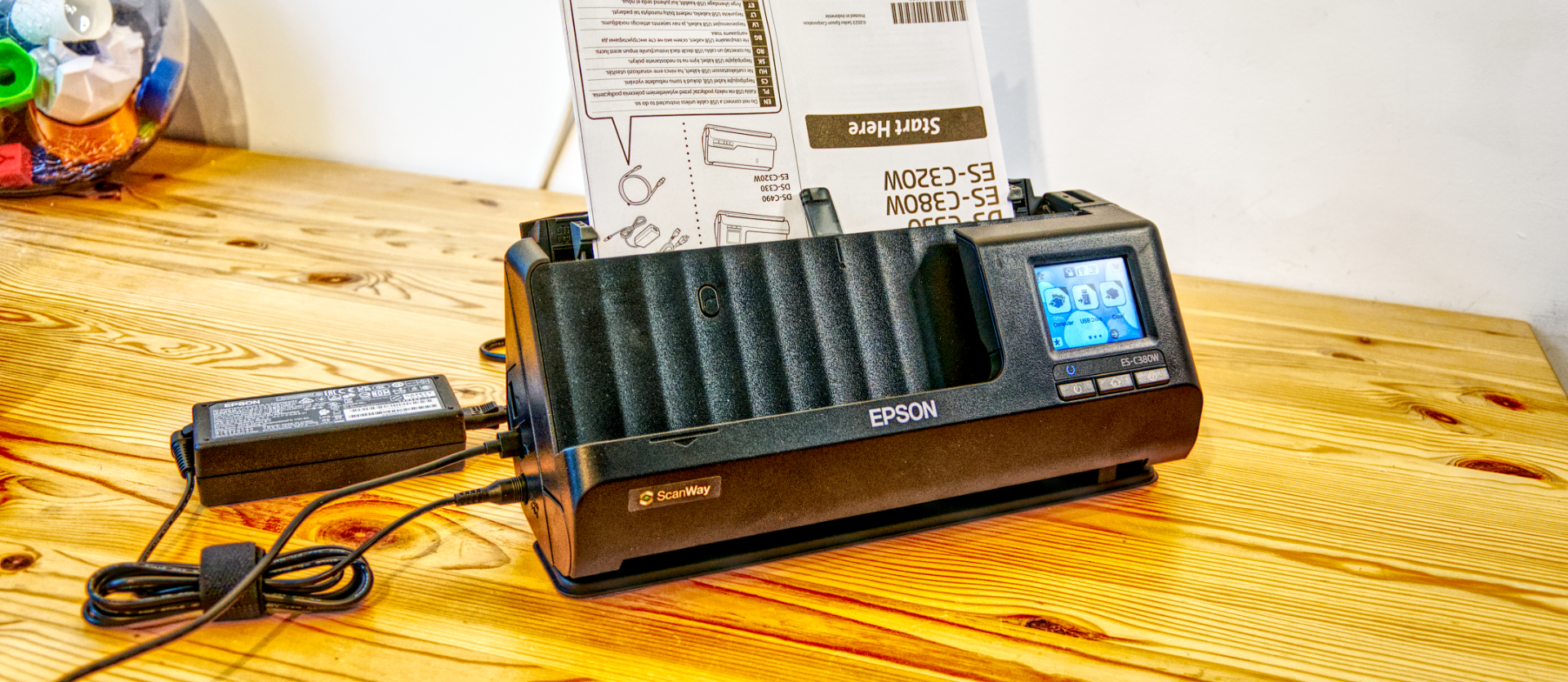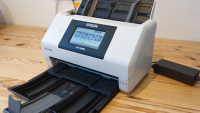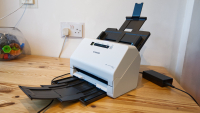TechRadar Verdict
A practical and easily transportable scanner that is perfect for auditors and low-volume scanning tasks. However, it isn’t cheap, its construction isn’t substantial, and it only comes with a single year of warranty.
Pros
- +
Highly portable
- +
Easy to use
- +
Scans to USB drive and computer
Cons
- -
Tiny touch screen
- -
Flimsy construction
- -
Not ideal for some workflows
Why you can trust TechRadar
Epson ES-C380W: 30-second review
The Epson ES-C380W that was sent to us for review came with the following hardware:
Scanner Type: Sheetfed Scanner
Document Feeder Capacity: 20 Sheets
Daily Scan Capability: 3,500 Pages
Dimensions: 296 x 104 x 125 mm
Networking: Via connected PC
Maximum Scan DPI: 1200
Pages per minute: 30 B&W, 30 Colour
Images per minute: 60 B&W, 60 Colour
Duplex scanning: Yes
Scan to the Internet: Yes
Scan to Network: Yes
Scan to USB: Yes
Software: TWAIN drivers for PC and Mac, Epson Device Admin, Epson Scan 2, Epson ScanSmart
Turning printed material into something easy to store and index is a requirement in many businesses, and a wide range of scanning hardware is available for this purpose.
Epson’s new ES-C380W scanner was designed explicitly with document imaging in mind, and it can hold up to 20 pages on the automated feeder and scan those documents at up to 1200 dpi in colour and monochrome.
The ES-C380W is slightly different from a typical small-footprint scanner is that is has a flat paper path mode that allows reasonably thick, up to 5mm, items to pass through individually, avoiding the need for a flatbed scanner.
With a size of just 296 x 104 x 125 mm (Width x Depth x Height) and a weight of 1.9 kg, this scanner is highly appropriate for off-site use that an auditor or solicitor might require.
Scans can be made directly to a USB stick or via a USB-connected computer, and via that host system, the captures can be redirected to popular Cloud-based services, including Google Drive, Dropbox, Evernote and OneDrive for business.
You can scan from within Microsoft Office applications, and the ES-C380W is compatible with Windows, Mac, Chromebook, Android Mopria, Apple AirPrint and Epson's SmartPanel application.
The caveats of this design are that it only comes with a single year of warranty, is mostly made of plastic, and has a tiny touchscreen only made for child-sized fingers.
Considering the price, most users will be expecting more than a year warranty, and Epson does enable the cover period to be extended for an additional cost.
Epson ES-C380W: Price and availability
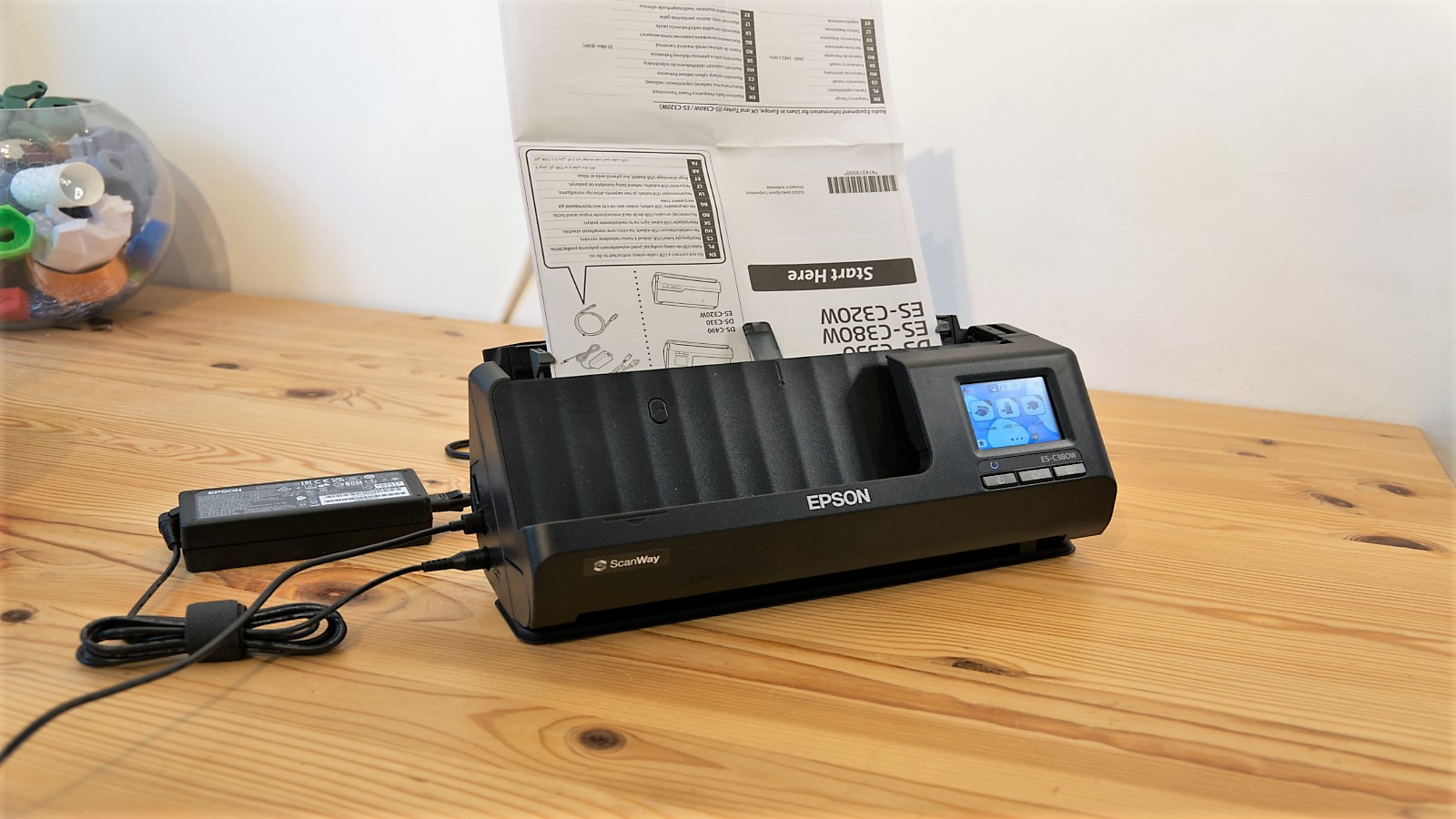
- How much does it cost? £370/ €482.90
- When is it out? It is available now
- Where can you get it? It can be bought from Epson or through an Espon dealer.
At the time of writing, the ES-C380W is only available in Europe.
The price of this scanner seems high, considering that it’s mostly made of plastic and only comes with a year of warranty.
A competitor product, like the Fujitsu-made ScanSnap iX1300, comes with a three-year warranty and WiFI for around 70% of the cost.
Another cheaper alternative with a similar specification is the Canon imageFormula R10, which uses a USB connection to a computer and has the same 20-sheet feeder but is nearer to 60% of the ES-C380W price.
For those willing to not have WiFi connections, there are several much cheaper options with a similar scanning specification.
- Value: 3.5 / 5
Epson ES-C380W: Design
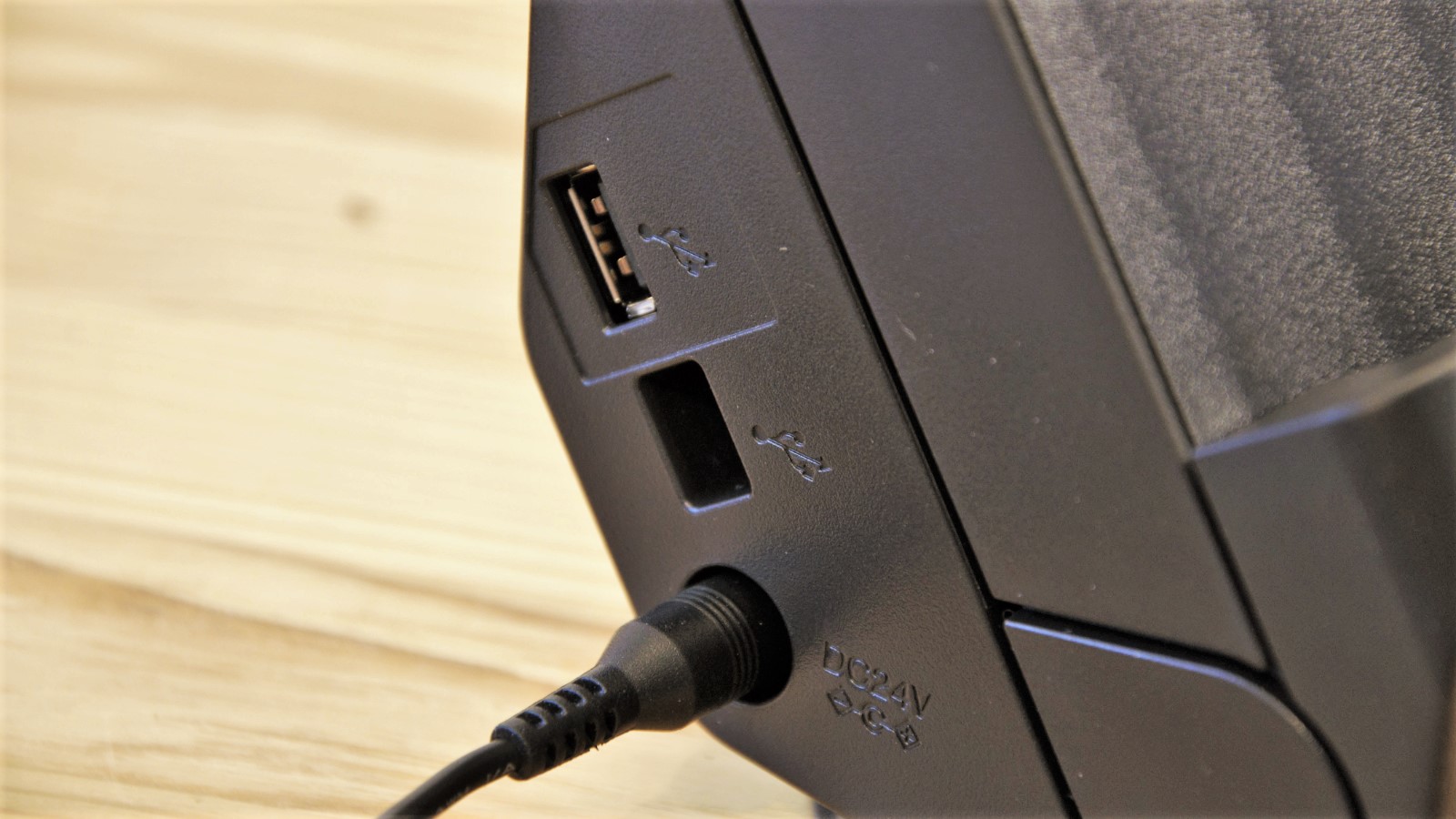
- Small footprint
- Two paper paths
- Awkward to configure
Most document scanners use a top-feeder system where documents are preloaded before bulk scanning can be initiated. The ES-C380W follows that basic plan, although the maximum number of sheets it can hold is just 20 in its standard paper path configuration.
This orientation has the smallest desktop footprint and makes this design ideal for the occasional scan job.
With only 20 pages loaded at any time, that’s 175 loading operations to hit the maximum 3,500 pages per day of potential, should anyone have the patience for that.
Frankly, anyone scanning more than 100 pages a day on a regular basis should be looking at a more robust design than this, a design that Epson only offers a single year of warranty on.
It might be more effective for scanning odd and thick content, such as passports, as it offers an alternative scan path mode where the input can be up to 5mm thick.
Using the straight paper path mode, many odd documents will pass through, although it can become fussy if the item isn’t entirely flat.
Alternatively, the normal mode scanning can be single or double-sided, and the paper is sent through a U-shaped path where it ends up in an output bin on the front of the machine. The thick content mode is a straight paper path that ejects the paper from the front of the machine, and offers single-sided scanning only.
Scanning operations can be controlled from the touch screen on the right front of the unit, or through the Epson ScanSmart application.
Scans can be directed to either an inserted USB stick or to a connected computer, with that journey redirected to Cloud storage if required. OCR (optical character recognition) can be performed on the scanned contents to provide an index that can be interrogated to identify the source image at a later date.
The process seems all very slick, and the scanner moves paper through rapidly, though occasionally so quickly that it jams.
What it also offers is a simple means (blank sheets) to separate document runs. Therefore, if you have 20 documents that are the contents of three different letters, for example, then you should put a blank page between the three parts. Alternatively, you can cut them up later using a PDF editor, but that’s yet another process to this workflow that isn’t required with a bit of preparation.
Epson has focused heavily on making the ES-S380W as easy to operate as possible, but it might not fit the scanning workflow of all busy offices where all post is scanned.
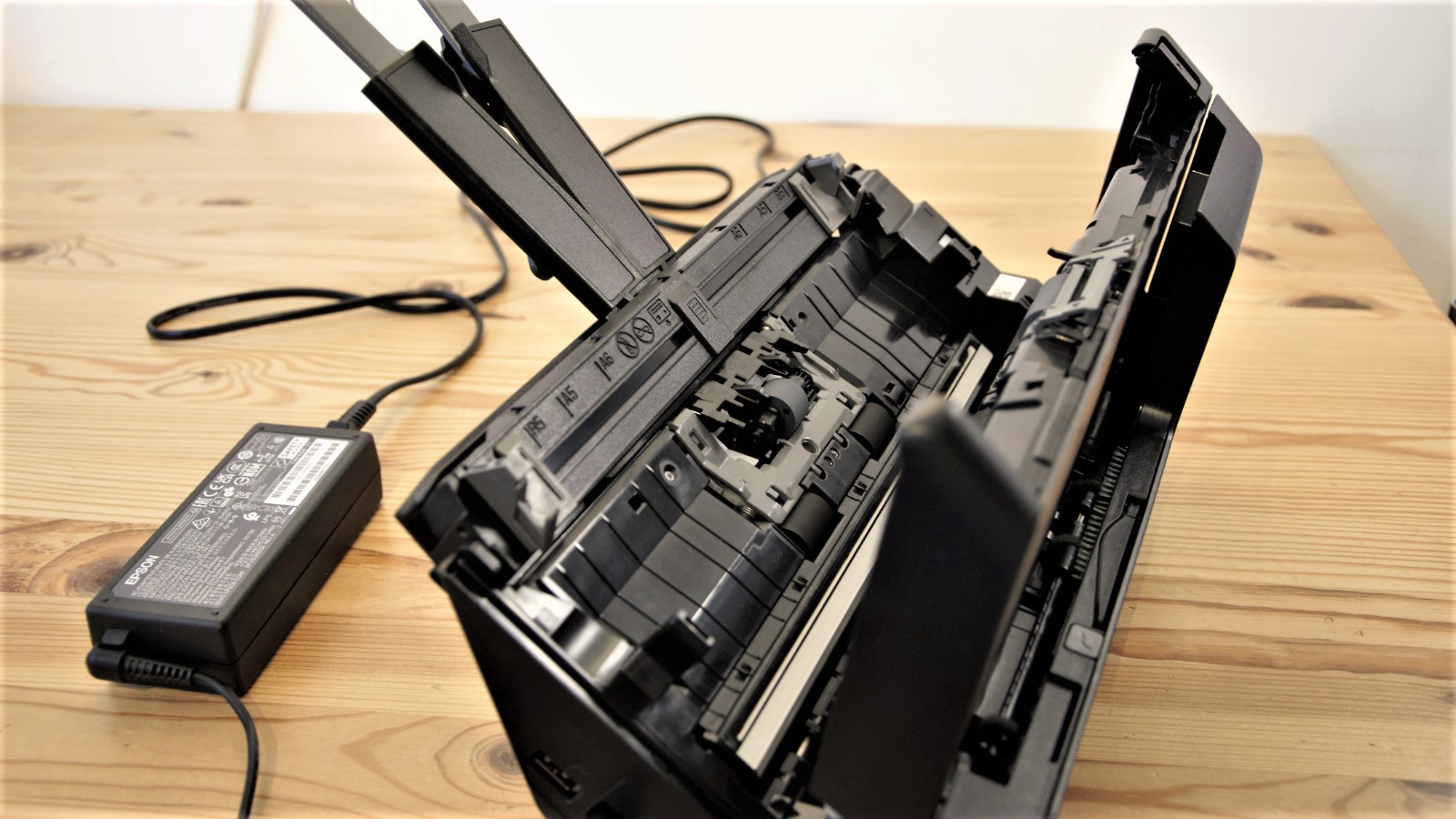
Other than the scan process, we have two other reservations about this design, the first being the generally flimsy construction of this scanner.
Where this is most noticeable is in the incredibly thin foot that the unit rests, which will easily bend with the minimum of hand pressure applied to it. The paper support arms at the rear also appear remarkably fragile, and when you open the scanner to clear a jam it the inside looks like a stray staple might easily obliterate it.
Our second issue is the size of the touch screen mounted on the right of the scanner, being just 50mm wide by 38 mm high. Many of the icons on this display are less than 4mm high, and yet these are meant to be selectable by an adult finger with a tip that is at least 10mm in width. The user experience is poor, but normally we wouldn’t be concerned about this as everything can be done from a connected computer. Except there are a number of actions, like selecting a wireless AP and inputting the password, that can only be done on the tiny screen.
Epson either needs to put screens on their scanners that are big enough for the job or extend the SmartScan application so it can configure everything.
- Design: 4 / 5
Epson ES-C380W: Performance
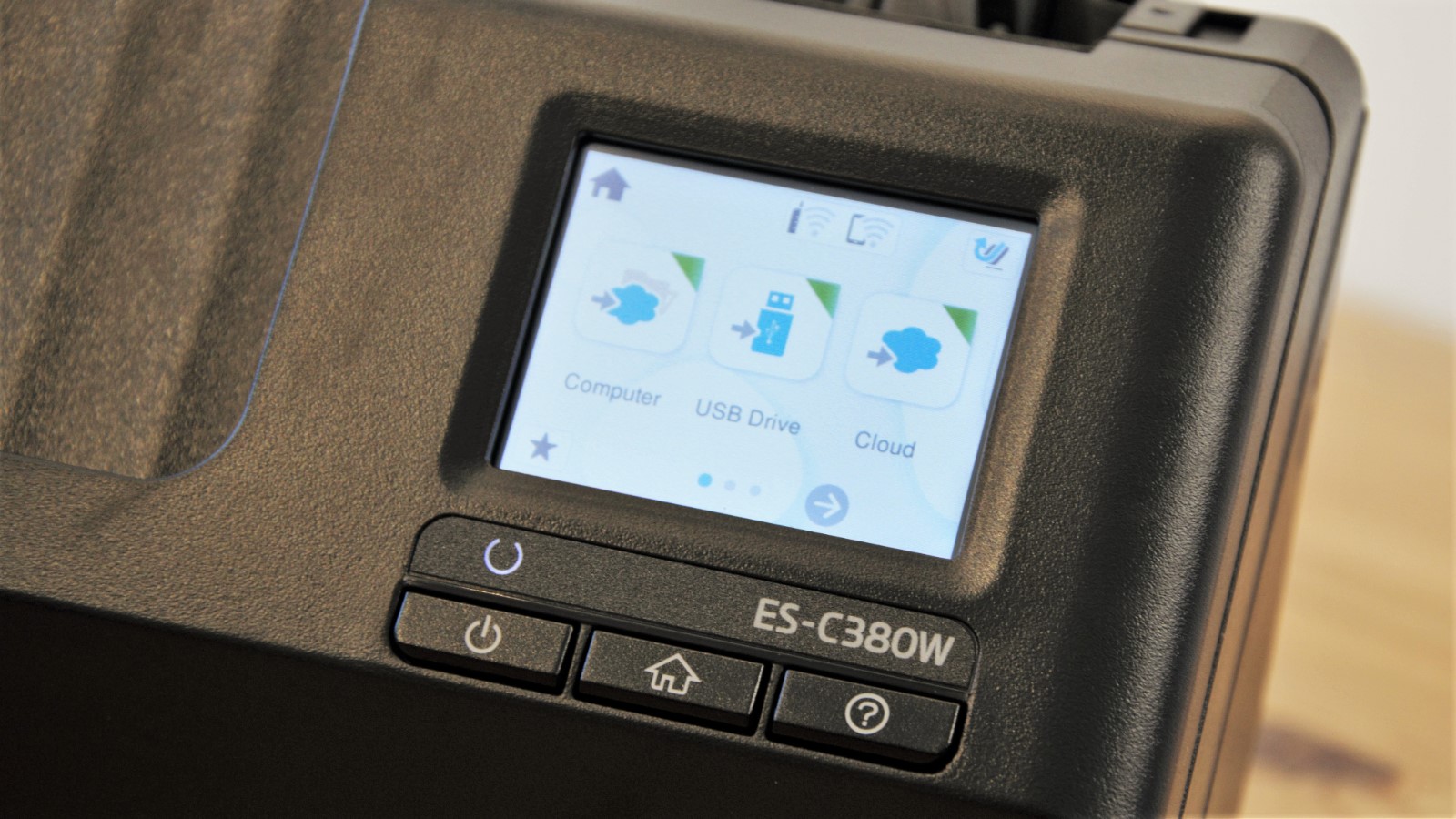
- Hard to hit quoted speeds
- Can jam with uneven stock
The quoted scanning speed for documents is 30 pages a minute for text documents and 60 pages for graphical images. Though, it can’t realistically hit those scores because the sheet feeder only holds 20 pages.
Scanning documents dictates it will hit a reload cycle at forty seconds that will probably take at least another ten seconds, maybe more, since the output bin needs to be emptied and the input slot primed before initiating another scan. That assumes that you have taken the time to carefully count another 20 pages and aren’t just grabbing pages you assume are numbered less than 20.
The scanning of images number is more flawed since the output bin will be filled in just 20 seconds, and if a reload occurs within another ten, a second reload will happen before 60 seconds have elapsed.
What we can confirm is that the ES-C230W can pull paper into the scanner and eject it at the quoted speed, but that doesn’t actually translate into those results in actual use.
When you consider the pre-organisation that the scanning process invariably requires and the post-processing needed, hitting the quoted 3,500-page duty cycle would be a genuine challenge in a working day for one person.
Where its performance is less nuanced is in the amount of power it consumes, with 3.3W in ready mode and only 1.0W in idle. This efficiency is down to the LED light source that the scanner requires and that being exclusively powered when the paper is passing through the scanner.
It also gets another environmental tick for being made from 30% recycled plastic, and as it's mostly plastic, that’s a significant contribution.
There are a few issues with paper feeding on occasion, we noted. The feeder doesn’t like any paper that isn’t perfectly flat, and it often jammed if we tried to send a folded document through. Also, guessing the thickness limit for the straight paper path can be tricky, as exceeding this will rapidly stop the operation.
It’s very noticeable how smoothly this scanner works in ideal conditions, those being fresh copy paper input, and how awkward it can become with thinner or thicker stock that isn’t entirely flat.
For very thick items, like books, this isn’t a substitute for a flatbed scanner.
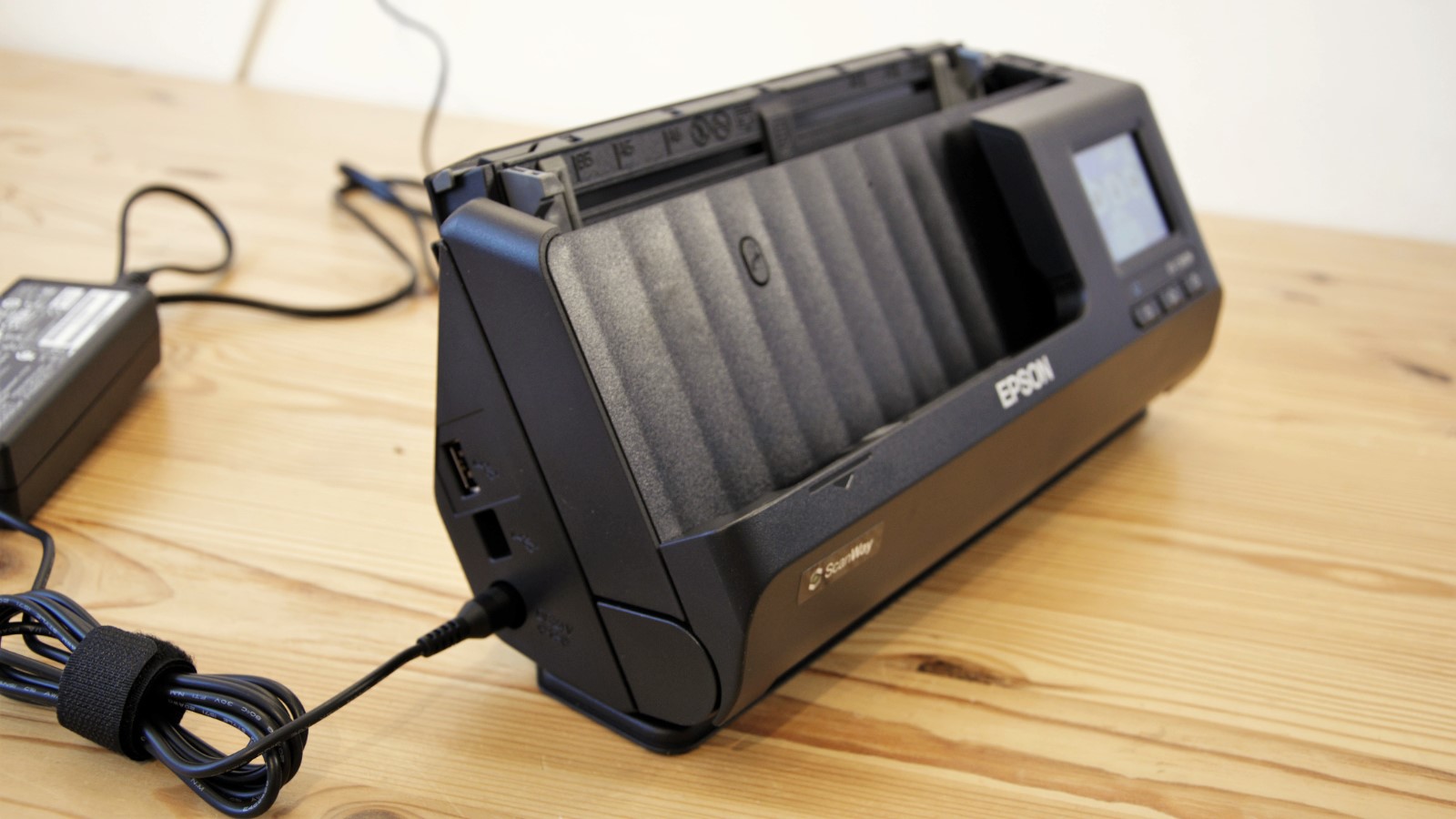
- Performance: 4 / 5
There are aspects of this scanner that are excellent, and for the most part, it does what Epson claims.
However, in the genre of small portable scanners for limited volume, it is more expensive than an equivalent design by Canon, and it has a worryingly short warranty period.
It is possible to extend the warranty, and Epson does make some replacement roller parts to swap should those become worn, but is that enough?
There is a fine balance here between making the ES-C380W robust enough to provide many years of solid service and light enough to take out of the office, and Epson went with lightweight over resilient.
Therefore, this isn’t a scanner we’d recommend for everyday scanning, but it's ideal for quick jobs of a few hundred pages when required.
And, the design does consider workflow, even if it can only digest 20 pages at a time.
Epson ES-C380W: Report card
| Value | It's only available in Europe, and the price is relatively high. | 3.5 / 5 |
| Design | Elegant design that can cope with fast A4 or Legal pages 20 at a time or thicker items like passports when required | 4 / 5 |
| Performance | Scans at a decent speed, even if the 20-page feeder slows things down considerablycessor. Not great for graphics processing. | 4 / 5 |
| Total | A decent performer, but the structure is flimsy, and the price is high | 4 / 5 |
Should you buy a Epson ES-C380W?
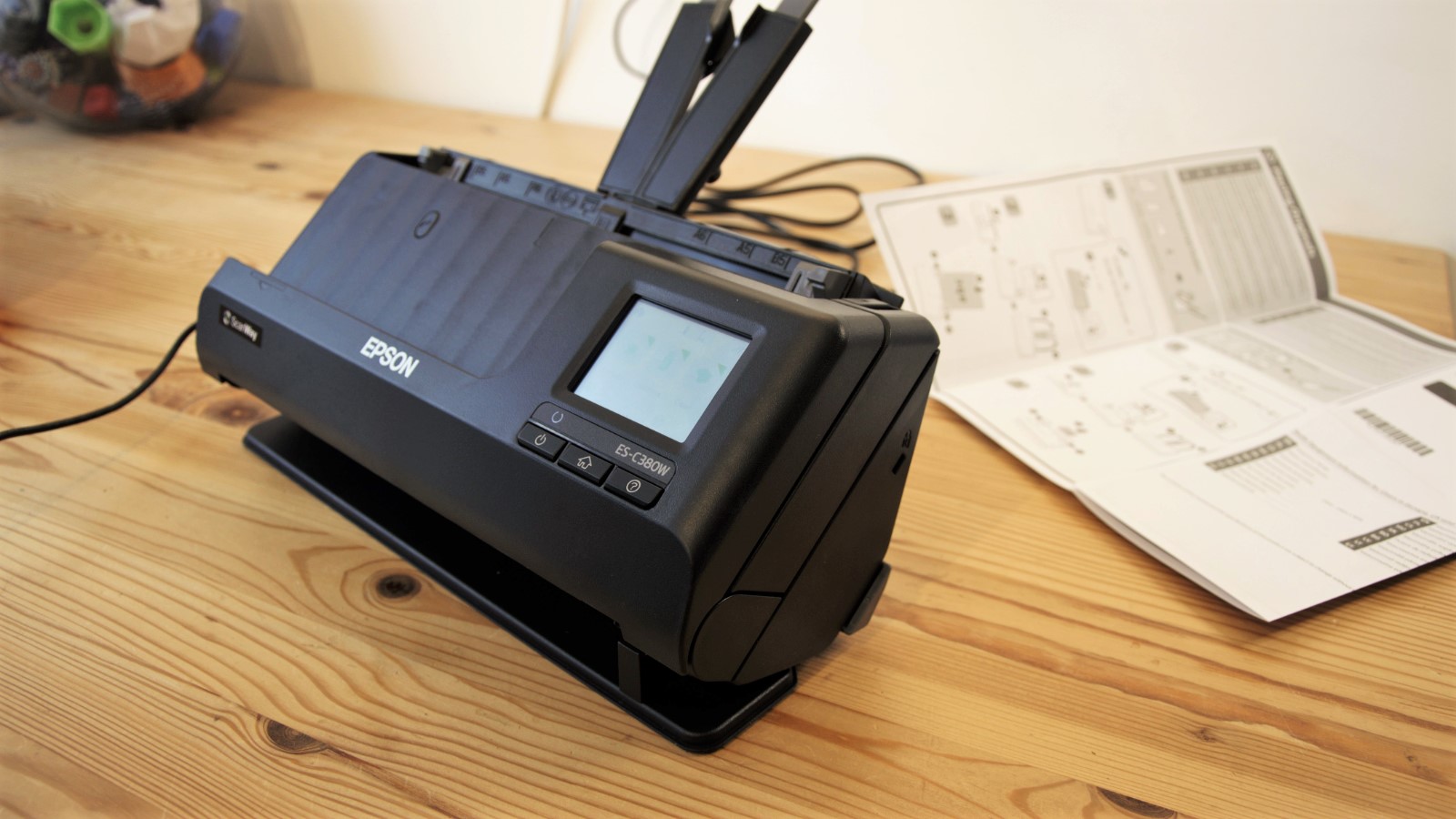
Buy it if...
You need to scan now and again
This isn’t a high-volume scanner, but if you occasionally need to copy a document, it is ideal.
It’s easy to relocate and doesn’t take up much desk space.
Thicker documents are a common requirement
Documents of up to 5mm can be processed by the ES-C380W, which would typically need a flatbed scanner. That the scanner can handle these requirements, and multi-sheet scanning could be remarkably useful and reduce desk clutter. But it won’t do books.
Don't buy it if...
You need high-volume scanning
While Epson quotes 3,500 pages daily as a duty cycle, this scanner would rapidly wear out if you sent that much paper through it. High volume requires more robustly built devices and a more sophisticated workflow than this hardware supports.
Have fat fingers
The tiny touch screen is a nightmare for anyone with sausage-like appendages, and the only way to use it effectively is to find a tablet stylus or other thin tool that won’t damage the screen. Most functions can be performed from the computer, but a few require pressing the touch screen.
Also consider
Epson WorkForce DS-790WN scanner
A bigger and even more expensive option, the DS-790WN can handle much larger scanning tasks than the ES-C380W with its 100-page feeder and higher scan speeds. It isn’t as portable as the ES-C380W, but its better suited to handle the challenges of large document processing.
Read our Epson WorkForce DS-790WN review for more information.
Canon ImageFORMULA R40 scanner
A cheaper design with slightly faster scanning, the ImageFORMULA R40 isn’t as portable and takes up more desk space. It also doesn’t network, regrettably. If you don’t travel to scan and have lots of office space to put it, this scanner could save you money.
Read our Canon ImageFORMULA R40 scanner review for more information.
Mark is an expert on 3D printers, drones and phones. He also covers storage, including SSDs, NAS drives and portable hard drives. He started writing in 1986 and has contributed to MicroMart, PC Format, 3D World, among others.
